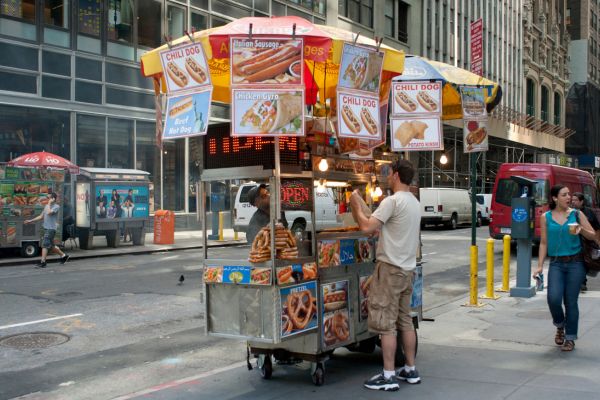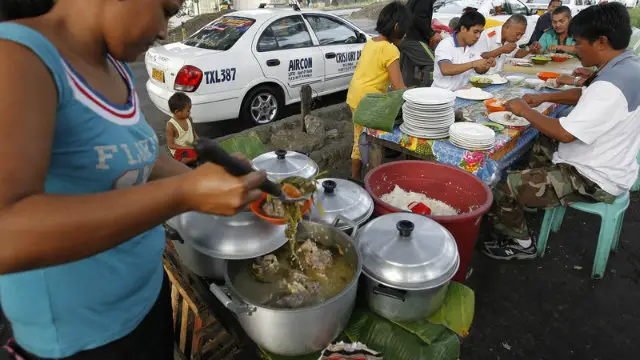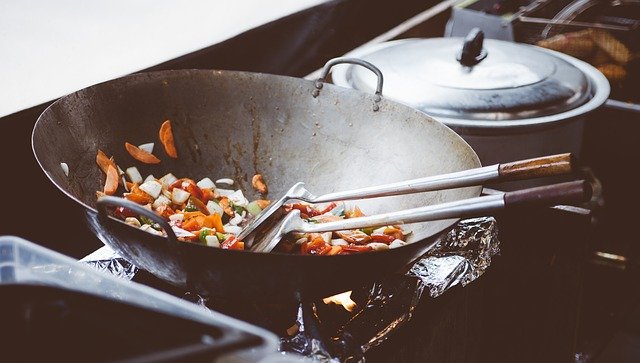The food cart sector in the Philippines is thriving, thanks to its low cost and easy accessibility. Food carts are small; moveable food booths can be seen at malls, parks, and on street corners, among other public places. There are local specialities, snacks, and beverages available, including Chinese, Korean, and Japanese food, among others. The business concept is simple, requiring only a little capital investment, low operating expenses, and few employees.
This makes it a popular choice among budding entrepreneurs, particularly those seeking a low-risk investment. In addition, the food cart business has been identified as a significant contribution to the Philippine economy, giving employment possibilities for many Filipinos.
Table of Contents
Why food carts attract customers
The Philippines’ food cart sector is extremely popular due to its cost and accessibility. Filipinos enjoy eating, and food carts offer various inexpensive meal options. This makes it a desirable option for those searching for reasonably priced yet delectable meals. Food carts are not only economical, but also convenient, as they may be found in malls, parks, and street corners, among other public places. Customers can have a snack or quick supper without having to travel far.
Why food cart businesses are popular investments
Due to its perceived benefits, the food cart industry is a popular choice among entrepreneurs. Firstly, it demands a minimal initial expenditure, which makes it accessible to a large number of entrepreneurs.
Second, the overhead expenses are generally cheaper than those of other businesses, possibly allowing entrepreneurs to profit substantially.
Thirdly, food carts are mobile and can be quickly moved from one area to another, allowing entrepreneurs to test several sites and determine the optimal spot for their business.
Fourth, the food cart market has a low entry barrier, which means that anyone with any level of education or expertise can establish a food cart business. Overall, the food cart sector has been viewed as a significant contributor to the Philippine economy, creating job opportunities for many Filipinos.
There are, however, considerable disadvantages to running a food cart business.
High competition
While the food cart sector is a popular and successful company in the Philippines, it is also highly competitive and crowded with competitors. Owing to the low entry barrier and startup expenses, numerous individuals begin their food cart enterprises, resulting in a crowded market.
As businesses compete for consumers, competition in the food cart market is expected to be fierce. If you sell the same type of turon with three other vendors in the market, you need to innovate and stand out from the competition. Do you integrate additional fillings like chocolate or jackfruit, proudly display sanitation certification when they don’t, or offer competitive pricing that beat the competition? It pays to be creative in building that unique selling proposition.
Businesses face the problem of differentiating their product offers from their competitors. Although several culinary options are accessible, business owners must develop a distinctive selling offer to attract customers. This can be accomplished by selling a particular sort of cuisine or by creating a unique experience compared to other food carts in the region.
Finding the ideal location
Finding ideal locations to establish food carts is expected to be a significant challenge for newcomers in the business. Popular places to set up food cart locations, such as shopping malls and public parks, are in high demand, thus entrepreneurs face competition from other food cart owners. Depending on the type of food you sell, foot traffic to your stall may not be guaranteed even on a high foot-traffic area.
While those selling grilled chicken will find establishing the business in the public market or a shopping mall to be a wise choice, those who rely on seasonal customers such as hotcake stalls near public schools. In the same light, food carts that sell juice bars that depend on seasonal produce will also find themselves in the same situation.
Even though the Filipino food cart industry offers numerous advantages for business owners, it is also intensely competitive, and in order to succeed, entrepreneurs must be unique and inventive.
Different times of the year
Different seasons of the year can bring impact to the food cart business. For example, those that cater to school children need to find another type of customers during school vacation. Grilled corn cob are only available during abundant corn harvest, so owners need to find other similar treats to sustain the business during lean months.
Nonetheless, food cart businesses may see lower sales during the wet season. Flooding and heavy precipitation can make it difficult for customers to reach food carts, particularly those located on roads or in open spaces. This could lead to lower foot traffic and sales for outdoor-reliant businesses. Furthermore, during the rainy season, clients may choose to have meals delivered or cooked at home rather than going out.
In addition, food safety problems may occur during the rainy season, which can negatively affect the reputation of food cart enterprises.
Food deterioration, for example, can occur during hot and humid seasons as a result of bacterial growth promoted by moist and humid surroundings. Dairy products and mayonnaise-based dressings can readily expire if not stored properly, posing a risk of foodborne illness. Humidity-induced moisture can stimulate mould growth on some foods like bread and vegetables, causing allergic responses.
Needless to say, food carts need to take necessary means to prevent exposure of food products to any health hazards.
The extreme hot weather conditions that plague the Philippines and nearby regions also pose health risk to those who work on food carts located in hot and humid conditions.
Space restrictions
Food cart businesses in the Philippines are typically restricted to designated zones, public markets, and commercial properties such as shopping arcades or malls. Local government units and property managers typically implement the limits to ensure the public’s safety and convenience by regulating the number and location of food carts.
These limits contribute to the order and safety of both stallkeepers and consumers. However, they can limit commercial potential for businesses. For example, food stalls are forbidden from operating on busy streets or high-traffic sections of retail malls if they violate government laws or mall zoning guidelines. This results in reduction of sales and revenue growth.
Also, food cart owners are often restricted to areas where other similar businesses operate. As a result, food carts may struggle to attract customers if they share the same products with neighboring stalls. If a hotdog stand in a shopping mall shares a zone with other hotdog food carts, its earning potential may be limited. This can limit their ability to expand their business or increase their profits.
In addition, regulations on food cart sites may hinder the ability of businesses to adapt to shifting market conditions. For instance, if there is a sudden increase in demand for food carts in a particular region, entrepreneurs may be unable to shift their businesses quickly enough to match the need.
In conclusion, while limits on food cart placements are essential for maintaining order and ensuring public safety, they might limit entrepreneurs’ business prospects. Entrepreneurs must carefully analyze the location and restrictions of their food cart enterprises and be proactive in discovering new growth and expansion opportunities.
Permitting and regulatory issues
Acquiring the proper permissions and adhering to rules can be difficult and time-consuming for Philippine food cart owners. Several government authorities may be involved, and entrepreneurs may be required to follow specified regulations and standards.
To establish a food cart company in the Philippines, investors must first seek a business license from the local government unit where the business is located. The criteria and fees for acquiring a business license vary by location and business type. Entrepreneurs may be required to seek additional licenses and clearances, such as sanitary permits, fire safety permits, and environmental permits, in addition to the business license.
Food cart companies may also face regulatory compliance challenges. Food safety, hygiene, and waste management requirements may all be subject to limits. Startups would have to invest a significant amount of money on equipment and infrastructure to meet these requirements. Failure to comply with such restrictions may result in fines or revocation of the operating licence.

Furthermore, the process of obtaining permissions and complying with regulations can be time-consuming and expensive for businesses. To obtain the necessary permits, entrepreneurs may be required to attend government offices, present relevant documents, and pay costs.
The entire process could take weeks or even months to complete, which can delay the business’s launch and result in revenue loss.
Obtaining permits and following regulations in the Philippines can be difficult and costly for food cart businesses. To maintain the safety and profitability of their business, entrepreneurs must understand the requirements and needs of their company and take proactive steps to secure the necessary licenses and follow regulations.
High operating costs
For Philippine food cart businesses, the cost of supplies and raw materials is a big hurdle to success. Businesses may struggle to find cheaper ways to acquire ingredients and maintain equipment, as labour, renting costs, and government taxes continue to rise.
In addition to the initial cost of purchasing ingredients and supplies, entrepreneurs may be required to purchase additional resources on a constant basis to meet demand. For example, food carts that provide freshly made meals may have to purchase new ingredients on a daily basis, which can quickly add up.
Fluctuations in prices of raw materials can also hurt the profitability of food cart operations. For example, price of ube is dictated by availability of supplies, and during peak festive seasons, it shoots up due to popular demand. Food carts that specialize in ube jam, ube tarts and similar products are forced to label higher prices on these products, making them less attractive to the buying public trying to find cheaper goods.
To stay in business, food cart operators may be pushed to seek cheaper options, such as lower quality ube types, which reduces the quality and flavour of the finished product.
To overcome these obstacles, Philippine food cart entrepreneurs may need to strategically source their ingredients and supplies. They might consider selecting reliable and affordable suppliers, engaging in price negotiations, and purchasing in large quantities to achieve cost savings. In order to ensure the profitability and sustainability of their businesses, entrepreneurs may find it necessary to make adjustments to their menu items and prices.
The price of ingredients and supplies might be a big obstacle for Philippine food cart entrepreneurs. To ensure the success and longevity of their businesses, entrepreneurs must carefully manage their budgets, source their materials and suppliers effectively, and modify their pricing and menu choices.
In order to operate a successful food cart business, it is important to ensure that all of the above elements have been considered in setting up your stall. Do a full research on competitors, target audience, stability of sources, government regulations and suitable locations. A well-researched business set up later is better than making impulse decisions without thorough research. Addressing such challenges can be a daunting task, but is necessary in ensuring the food cart will go through fewer problems to solve when operating the business.








